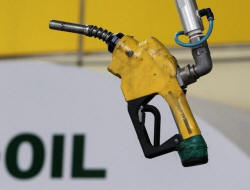|
 Oil
falls on U.S. supply record, weak demand outlook Oil
falls on U.S. supply record, weak demand outlook
 Send a link to a friend
Send a link to a friend
[February 11, 2016]
By Simon Falush
LONDON (Reuters) - Oil slid on Thursday,
dented by record U.S. crude inventories, worries about the demand
outlook and a Goldman Sachs forecast that prices would remain low and
volatile until the second half of the year.
|
|
 In a sign that producers are still competing for market share by
lowering prices, Iran offered its crude to Asia at a discount to
rival OPEC producer Saudi Arabia. In a sign that producers are still competing for market share by
lowering prices, Iran offered its crude to Asia at a discount to
rival OPEC producer Saudi Arabia.
Brent crude futures <LCOc1> were down 51 cents at $30.33 per barrel
at 6.57 a.m. ET.
U.S. West Texas Intermediate (WTI) crude futures <CLc1> were at
$26.37 per barrel, down $1.08 and not far off the $26.19 intraday
low hit in January that was their weakest price since 2003.
"We're grinding lower on bearish fundamentals," said Bjarne
Schieldrop, chief commodity analyst at SEB in Oslo.
"There's a price fight within OPEC for Asian market share, and there
are worries that storage capacity is going to be breached."

He added that oil's fall was also part of a general move in global
markets away from riskier assets. Investors flocked to safe haven
assets such as gold, the Japanese yen and top rated bonds.
Inventories at the Cushing, Oklahoma delivery point for U.S. crude
futures rose to an all-time high just shy of 65 million barrels,
data from the government's Energy Information Administration (EIA)
showed on Wednesday.
Goldman Sachs said the overhang in oil supplies, together with an
economic slowdown in China, means prices will remain low until the
second half of the year.
"We expect oil prices will continue to fluctuate between $20 per
barrel (operational stress level) and $40 per barrel (financial
stress level) with significant volatility and no price trend until
2H2016," it said in a client note.
[to top of second column] |

OPEC producer Iran has cut its Heavy crude price for export to the
Mediterranean by a larger amount compared with top exporter Saudi
Arabia as Tehran seeks to attract more buyers after sanctions were
lifted.
The region is one of the battlegrounds for Iran as it tries to
reclaim market share lost in the last few years when western
sanctions restricted Iranian crude imports.
Oil prices have fallen almost 75 percent since mid-2014 as competing
producers pump 1-2 million barrels of crude every day in excess of
demand, just as China's economy grows at its lowest rate in a
generation.
(Reporting by Simon Falush; Editing by Dale Hudson)
[© 2016 Thomson Reuters. All rights
reserved.] Copyright 2016 Reuters. All rights reserved. This material may not be published,
broadcast, rewritten or redistributed.
 |